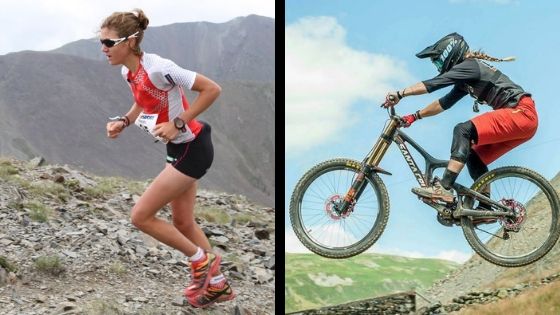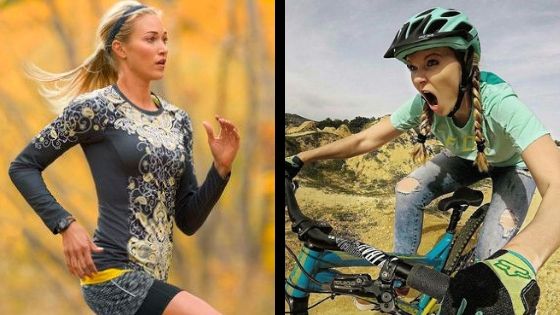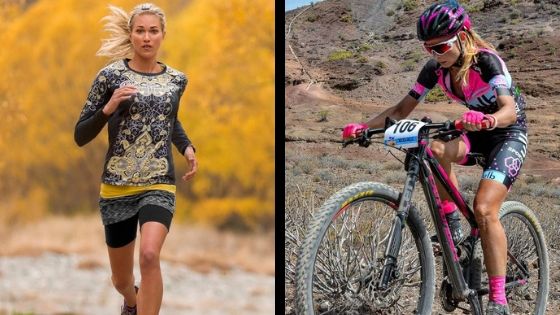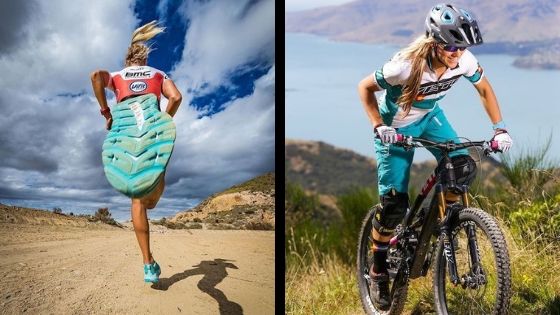
David and I got into a heated debate on the way back home from the State 10k Championship last Sunday. The topic of discussion was whether trail running or mountain biking was better for you or not. Unable to reach any type of consensus we decided to turn to Google for the answers.
Trail running vs. Mountain biking: which is better for you? Based on 14 areas of analysis, it is evident that trail running is slightly better for you than mountain biking.
| Trail Running | Mountain Biking | |
| Burning Calories | 0 | 1 |
| Easier To Learn | 1 | 0 |
| Cost Of Entry | 1 | 0 |
| Danger Level | 1 | 1 |
| Excitement Level | 0 | 1 |
| Injury Risk | 0 | 1 |
| Endurance Improvement | 0 | 1 |
| Cool Factor | 0 | 1 |
| Sex Appeal | 1 | 0 |
| Better In Winter | 1 | 0 |
| Maintenance Load | 1 | 0 |
| Mechanical Issues | 1 | 0 |
| Yield Triangle | 1 | 0 |
| Exploration Potential | 0 | 1 |
| TOTALS | 8 | 7 |
While I have competed in both trail running, David has not. So it would only be fair that David chooses the 14 categories for us to rate trail running against mountain biking to see which sport comes out on top as being better for you.
A case of swings and roundabouts
As is so often the case when comparing two sports that are in essence good for you, each sport has its strengths and weaknesses. Therefore, with either sport what you gain on the proverbial swings you will lose on the roundabouts and vice versa. In this comparative study trail running and mountain biking only showed a clear overlap in one of the fourteen areas of comparison.
What did become abundantly clear is that the two sports are amazingly complimentary. Areas where train running is weak, mountain biking is strong and vice versa. Therefore you will develop better as a rounded athlete by doing both activities. This will also massively reduce your chances of getting injured.
Which option burns more calories
When it comes to looking at the burning of calories, do we look at calories per hour or calories per workout. The two are not necessarily one and the same.
Sure I can burn 1000+ calories per hour trail running, but the longer I keep going at that pace the more wrecked my legs are and need longer recovery before my next long run. My mountain biking burn rate is 400 calories an hour on the flat and 800 calories an hour going uphill.
However, I am able to handle five times more training volume on the mountain bike over the course of a month than I can by trail running.
Just like the Ginger Runner I have a tendency to overeat when I am doing just trail running because my hunger level always seems to exceed my calorie burn rate. Because I race near the back of the pack it seems an awful waste to leave an aid station with such a mountain of delicious uneaten food.
So, when it comes to weight loss for me, I will score the calorie burning point to mountain biking. Trail running: 0 Mountain biking: 1
Is it easier to learn mountain biking or trail running
The basics of trail running are very easy to learn, at least they were for me. It took years of running on increasingly technical trails before I had my first really spectacular face plant. Though at the same time I have had more than one close call, tripping over something and somehow still staying upright.
Mountain biking was a completely different experience. Even today, after decades, my lack of courage in my ability means that I will get off and push the bike over technical terrain.
I learned mountain biking on a full-rigid mountain bike. I still remember my first ride on my hard rail. The front wheel hit a rock that I had bounced over many times before. Instead, my too soft suspension absorbed the impact and completely bottomed out the shock absorbers. As my body pitched forward over the down-sloping bike, the shocks bounced back. This launched me cleanly over the handlebars. Well, cleanly until I landed.
One thing that I will say is that mountain biking has taught me to look further up the trail than what I used to do when just trail running. That has helped me to avoid obstacles that I would normally trip over if I was just looking at my feet.
I rate trail running as easier to learn than mountain biking. Trail running: 1 Mountain biking: 0

Is trail running cheaper than mountain biking
When it comes to cost of entry mountain biking is a far more equipment dependent sport that extends well beyond the obvious bike.
For the most part trail running requires pulling on a well fitting pair of trail shoes and heading out the door.
Almost all of the additional gear that trail runners buy can overlap into mountain biking as well. My GPS unit, head torch, hydration system and protective eyewear that I acquired for trail running have all also been used on the mountain bike.
Even at entry level, the mere addition of the bike makes mountain biking at least ten times more expensive than trail running. Trail running: 1 Mountain biking: 0
Relative danger between trail running and mountain biking
The chances of falling in both trail running and mountain biking are relatively high. However, because you land on bushes and dirt most of the time your risk of getting seriously hurt is quite low. What’s more, it is through the process of falling that you gain the skills needed to excel at both sports.
It isn’t a ride till there is blood.
Conrad Stoltz – 7 time World Champion
A common theme that I hear relating to beginner mountain bikers is that you need to ensure that your first aid kit is well stocked with everything you need for treating cuts and scratches. In my experience that holds equally true for trail running.
The flip side of the argument that trail running is always safer than mountain biking is the anomaly of Killian Jornet. His ridge running videos on YouTube are legendary.
When it comes to danger, it is all about the trail that you choose for your outing. Whether you ride or run the trail, a dangerous trail remains a dangerous trail. I base my trail choice in line with my skill level. Trail running: 1 Mountain biking: 1
Which one offers the greatest excitement
I suppose that when it comes to excitement levels I may be a little different from many of you.
I come from a background of rock climbing. That makes me reasonably comfortable when traversing steep ground. I have learned to keep my focus on the trail ahead of me rather than the void. How else do you cope with Via Ferrata without losing your mind?
So for me, a trail run would need to get very sketchy, especially down a steep descent with my dodgy right knee for the adrenalin to really kick in.
Simply because I feel so much more secure on my feet than I do on two wheels, my pulse always spikes way more riding over technical ground than it does running over that same terrain. Trail running: 0 Mountain biking: 1
Which sport carries the greatest injury risk
When it comes to injury risk, the biggest factor to bear in mind is looking at which sport has the higher impact.
Sure when it comes to falling and crashing mountain bike crashes will tend to have a higher impact as you are further from the ground as well as usually moving faster.
However, that is not the type of injury risk we are talking about. Instead, let’s look at the chances of you getting injured from actually doing the activity.
When it comes to mountain biking, the most common cause of all injuries is your position on the bike. Something as simple as a saddle shifting to the side, dropping, or sliding back can cause massive problems in your hips and lower back. That has happened to me a few times over the years.
When it comes to mountain biking and knee problems, there are two causes. The first and most common is that you have set your saddle to the wrong height. The rule of thumb is that if the pain is just above the knee, raise your saddle. If the pain is just below your knee, lower your saddle.
What if the pain is in the knee, you may ask? That leads me to the second most common cause of knee problems for mountain bikers. The second most common cause of knee injuries for mountain bikers is a shoe cleat that has shifted out of position.
One very simple prevention measure will prevent all of these from happening. Start by getting a proper bike fit. Once your bike and shoe cleats are set in their optimum positions for you, take a permanent white marker and mark the positions of everything on your bike that can possibly move out of alignment. That way you can see at a glance if something needs adjustment every time you clean your bike.
On the other hand, trail running injuries seldom have anything to do with equipment set up and more to do with doing too much too soon. That has been my personal experience over the years as well. Like so many of you, I have tended to increase my run volume in line with my cardio fitness level.
The trouble is that muscle, ligament, tendon, and joint strength to not increase at the same tempo as your cardio fitness. So doing too much volume too soon is a recipe for disaster.
Most often it is the repetitive impact of hard surfaces. Being on trail alleviates that to a certain extent, but in dry climates you gave trails that are still very hard underfoot.
I put together a list of my preferred shoes that I use to compensate for the different types of trails. Have a look at that list by following this link.
The next injury related challenge relates to the fact that trails are hardly ever pancake flat. If, like me, you live in a mountain village you will find that your trail choices are limited to up hill or down hill. The only way that I can get any flat running at all is if I get onto a treadmill.
The trouble with increasing volume too quickly on hilly terrain is Achilles and calf tightness on the one hand and the ever-lurking shin splints on the other. This is especially true for too much uphill running without giving your body time to adapt. I wear the badge for that one.
So, not counting crashes I will still count it as easier to get injured from trail running than mountain biking. Trail running: 0 Mountain biking: 1
Which sport will improve your endurance the most
When it comes to building your endurance there are a couple of factors that play a key role. Most important is consistency. The intensity of your effort must be such that you can repeat it day after day. Doing a single long workout and then needing to take three to four days off to recover will not be as effective.
Next, you build endurance by doing the vast majority of your training at the lower heart rate of aerobic threshold. For me that is holding a heart rate of under 148 beats per minute.
The trouble is, for me, keeping below 148 beats per minute going downhill is fine. On the flat, it is still a challenge most of the time. However, when the trail tilts up it becomes near impossible to keep my heart rate down even at walking pace.
On the mountain bike, however, I am generally able to keep my heart rate low enough thanks to the light gearing. This is true even when I ride uphill unless it gets really steep or loose and technical.
There is a guy that I know that ran a 2:43 marathon doing only 10 miles a week of running. He did all of his endurance training on the bike and did 20 minutes of run drills every day so that the couple of runs that he did do were with good, efficient form. He also used the runs that he did do to lock in the feel of his goal pace.
Therefore I will rate mountain biking as a more effective way to build endurance. Trail running: 0 Mountain biking: 1

Which scores the better cool factor
The cool factor relies heavily on the presence of physical equipment. I remember back in my high school surfing days and the cool factor related to a surfboard lashed to the roof rack of a car.
This gave rise to the term Highway Surfer decades before it became a mobile phone game. The term referred to someone who bought a surfboard and lashed it permanently to the roof racks on their car for the sole purpose to look cool. Highway Surfers never ever actually put a toe in the water.
The same applies when comparing trail running to mountain biking. Somehow a pair of muddy trail shoes dangling from the tow hitch of your truck won’t attract the same kind of attention as the front wheel of a mountain bike hooked over the tailgate.
So, on the cool factor, my vote will go to mountain biking. Trail running: 0 Mountain biking: 1
Does mountain biking or trail running have more sex appeal
When it comes to sex appeal we need to look at different criteria to the cool factor that we were looking at earlier.
Let’s take a look at what trail running has going for it in the sex appeal stakes. With the guys, you have shorts and tanned, toned torsos. And on the girl side, running skirts, crop tops, and ponytails that sway from side to side.
Conversely on the side of cycling and mountain biking you have figure hugging nylon lycra that tends to accentuate every single lump and bump. Especially those bumps that you would prefer were not advertized to the world. Add to that helmets and hat hair.
Therefore the sex appeal point goes to trail running. Trail running: 1 Mountain biking: 0
Which is the better winter choice
My enjoyment of training during winter is determined by the weather. Getting wet and getting cold are not my favorite things to do. That was one of the motivating factors to live where I live.
One of the factors that impact on how cold you get is wind chill. Whether you stand still in the cold wind or move quickly through cold air, the effect on your body is the same.
The faster you move the greater the wind chill. You can compensate for wind chill by something called the CLO factor of the activity that you are doing. The CLO factor of an activity is how much body heat you are able to generate. Downhill mountain biking I hardly turn a pedal and just get cold in the winter air. At least with downhill trail running, I am still running and therefore able to generate some heat and I am usually moving slower.
On that basis, my vote for winter goes to trail running. Trail running: 1 Mountain biking: 0
Which option carries the lighter maintenance load
Any sport you do requires a certain amount of maintenance in order to avoid future mishaps. Under most circumstances maintenance involves sessions of strength training or those sessions with your foam roller that you try to avoid.
However, mountain biking takes the concept of maintenance to a whole new level. You have chain cleaning. You have disc brake adjustments because almost always there will be a rubbing brake. You need to check tires for potential debris. Then finally your bike will likely need a wash as well. All of this cleaning and adjustments are what awaits you after each and every ride on your mountain bike. On top of that, you have your foam rolling and body maintenance too.
Therefore, in my opinion, trail running carries the lighter maintenance load if the two. Trail running: 1 Mountain biking: 0
How about mechanical issues out on the trail
Ah yes, the beloved mechanical. When I get back from a trail run I generally check the soles of my shoes. I will often find a thorn or even a shard of glass embedded in a shoe. Why is it almost always my right shoe? But I digress. The point I am making is the debris that I trod on along my run did not slow or hinder my run in any way.
The only reason why I take the time to check my shoes for thorns and debris is back in the day when I didn’t I landed up with a cut foot from a shard of glass that had worked its way through the sole of my shoe.
Compare that to the mechanical challenges of mountain biking. Those same thorns and shards of glass that had hardly given me pause for thought in any way, will bring my mountain bike ride to a sudden halt. Along the way, I learned the useful hack of putting my spare tubes inside old socks.
Bouncing along mountain bike trails causes your spare inner tube to rub against the inside of your tubby bag, wearing holes in your spare tube. The old socks solve that problem.
Aside from the all too common punctures. You have other exciting challenges. There are the relatively painless challenges of rubbing brakes, slipping gears and a dropped chain. While these may annoy you, they won’t leave you stranded tens of miles away from the trailhead. Snapping a rear derailleur hanger or a chain will do that to you, however.
Trail running leaves you with far far less mechanical issues. Trail running: 1 Mountain biking: 0
The dreaded yield triangle and who has right of way on the trails
You have no doubt seen them out on the trail. That dreaded yield triangle. The one that indicates who has the right of way out on the trails.
Horses and horse riders have the apex right of way on the trails, mainly because too many sudden movements can give a horse a fright, causing it to bolt, resulting in massive injury risks.
At the same time, encountering horses on the trail is a rare occurrence. In the over thirty years that I have been trail running and mountain biking I think there have been three occasions where I have encountered horses out on the trail. Though it may have been four times.
Hikers and trail runners enjoy equal status immediately below horses on the yield triangle, both above dogs on leashes.
Coming in at the bottom of the hierarchy, mountain bikers need to yield to everyone. From personal experience, this can be especially challenging when going uphill.
When I first started mountain biking I was a whole lot less dexterous at unclipping my shoes. Therefore the process of yielding to other trail users would invariably involve the combination of a bloody knee from falling over and getting laughed at by those I was yielding to.
My next problem would be that once I had stopped and yielded to the other trail users on the way up the hill, I would not be able to get going again. This would mean pushing or carrying my bike for the rest of the way up the hill.
In some areas in Texas there is a new category of trail user that now ranks even below mountain bikes. That is the ubiquitous electric scooter. In some areas electric scooters out number all other trail users combined at a ratio of two to one or more.
The faster trail runners and mountain bikers move, the louder their breathing becomes. This in itself can alert other trail users to their presence. On the other hand, electric scooters are silent and fly around the trail at twenty-five miles an hour or faster.
Most trail runners and mountain bikers have been trail users for a longer period of time resulting in a certain degree of trail etiquette. Those Texas trails are now flooded with electric scooter riders that are complete newbies regarding trail usage.
Based on the hierarchy that has been decreed on the yield triangle, trail running wins out over mountain biking. Trail running: 1 Mountain biking: 0

Which activity to choose when you want to fully explore a new area
When it comes to exploring as many trails in a new area as quickly as possible you will want to be covering a lot of ground quickly. This is even more so if you have consecutive days of really good weather.
If the weather is good, you will want to spend more time exploring trails and more consecutive days doing that.
Because it is so much quicker and easier to recover from a mountain bike ride as well as being able to cover more trails more quickly, using your mountain bike to explore a new area will be your best option to start with.
What I do is I start exploring with my mountain bike and if I encounter trails that are too technical for my skill level of mountain biking I will go back and redo those specific trails as trail runs.
Therefore the point for which option to use when you want to fully explore a new area will have to be mountain biking. Trail running: 0 Mountain biking: 1
